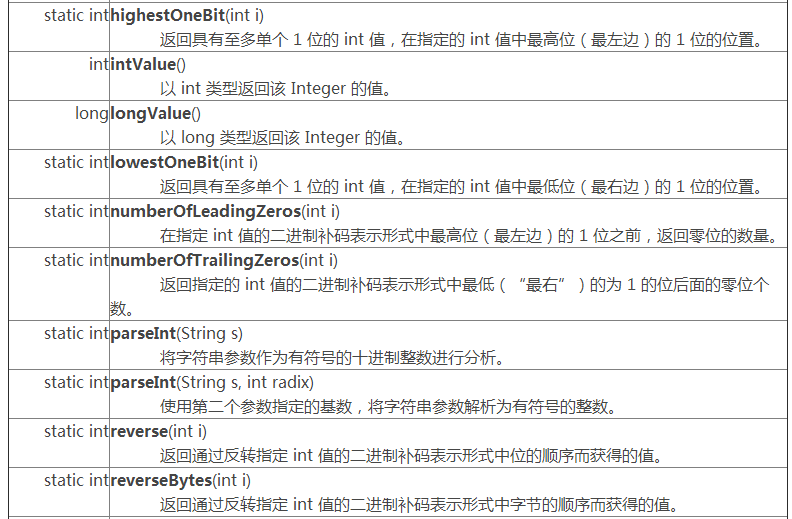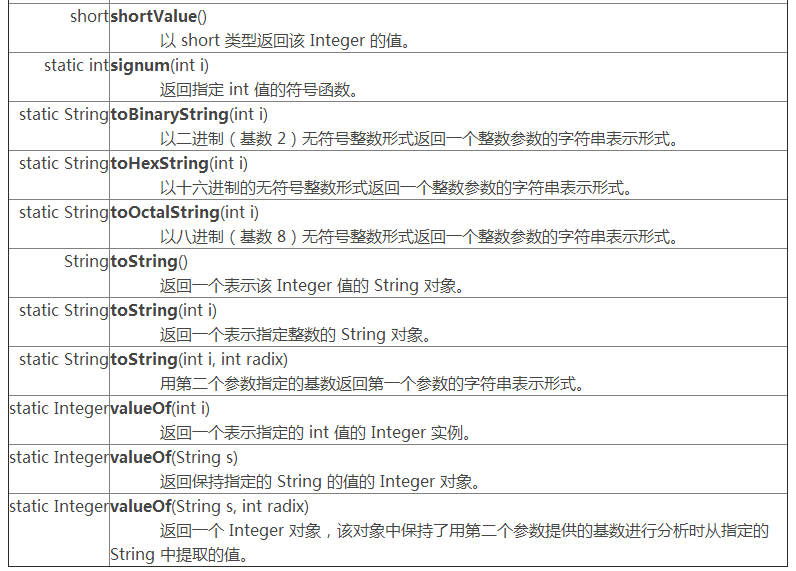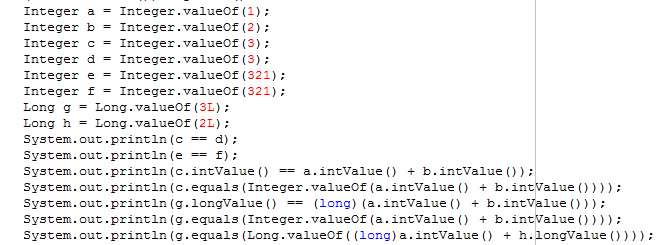突然发现自己对Integer i = 10;这种语法不太明白,于是乎有了这篇文章,那么在讲解 Integer 之前,我们先看下面这段代码:
|
1
2
3
4
5
6
7
8
9
10
11
12
13
14
15
16
17
18
|
public static void main(String[] args) { Integer i = 10; Integer j = 10; System.out.println(i == j); Integer a = 128; Integer b = 128; System.out.println(a == b); int k = 10; System.out.println(k == i); int kk = 128; System.out.println(kk == a); Integer m = new Integer(10); Integer n = new Integer(10); System.out.println(m == n);} |
大家可以先思考一下结果是什么?
答案是:
true false true true false
至于为什么是这个结果,下面我们来一一介绍。
1、Integer 类简介
首先我们大致看一下Integer是什么,Integer 类在JDK1.0的时候就有了,它是一个类,是 int 基本数据类型的封装类。

基本API如下:






图片引用:http://blog.csdn.net/litong09282039/article/details/46309541
2、Integer 类和 int 的区别
①、Integer 是 int 包装类,int 是八大基本数据类型之一(byte,char,short,int,long,float,double,boolean)
②、Integer 是类,默认值为null,int是基本数据类型,默认值为0;
③、Integer 表示的是对象,用一个引用指向这个对象,而int是基本数据类型,直接存储数值。
3、Integer 的自动拆箱和装箱
自动拆箱和自动装箱是 JDK1.5 以后才有的功能,也就是java当中众多的语法糖之一,它的执行是在编译期,会根据代码的语法,在生成class文件的时候,决定是否进行拆箱和装箱动作。
①、自动装箱
一般我们创建一个类的时候是通过new关键字,比如:
|
1
|
Object obj = new Object(); |
但是对于 Integer 类,我们却可以这样:
|
1
|
Integer a = 128; |
为什么可以这样,通过反编译工具,我们可以看到,生成的class文件是:
|
1
|
Integer a = Integer.valueOf(128); |
这就是基本数据类型的自动装箱,128是基本数据类型,然后被解析成Integer类。
注意:自动装箱规范要求 byte<= 127、char<=127、-128<=short <=127、-128<=int <=127都被包装到固定的对象中(缓存)。
②、自动拆箱
我们将 Integer 类表示的数据赋值给基本数据类型int,就执行了自动拆箱。
|
1
2
|
Integer a = new Integer(128);int m = a; |
反编译生成的class文件:
|
1
2
|
Integer a = new Integer(128);int m = a.intValue(); |
简单来讲:自动装箱就是Integer.valueOf(int i);自动拆箱就是 i.intValue();
4、回顾开头的问题
|
1
2
3
4
5
6
7
8
9
10
11
12
13
14
15
16
17
18
|
public static void main(String[] args) { Integer i = 10; Integer j = 10; System.out.println(i == j); Integer a = 128; Integer b = 128; System.out.println(a == b); int k = 10; System.out.println(k == i); int kk = 128; System.out.println(kk == a); Integer m = new Integer(10); Integer n = new Integer(10); System.out.println(m == n);} |
我们使用反编译工具Jad,得到的代码如下:
|
1
2
3
4
5
6
7
8
9
10
11
12
13
14
15
16
|
public static void main(String args[]){ Integer i = Integer.valueOf(10); Integer j = Integer.valueOf(10); System.out.println(i == j); Integer a = Integer.valueOf(128); Integer b = Integer.valueOf(128); System.out.println(a == b); int k = 10; System.out.println(k == i.intValue()); int kk = 128; System.out.println(kk == a.intValue()); Integer m = new Integer(10); Integer n = new Integer(10); System.out.println(m == n);} |
打印结果为:
true false true true false
首先,直接声明Integer i = 10,会自动装箱变为Integer i = Integer.valueOf(10);Integer i 会自动拆箱为 i.intValue()。
①、第一个打印结果为 true
对于 i == j ,我们知道这是两个Integer类,他们比较应该是用equals,这里用==比较的是地址,那么结果肯定为false,但是实际上结果为true,这是为什么?
我们进入到Integer 类的valueOf()方法:

分析源码我们可以知道在 i >= -128 并且 i <= 127 的时候,第一次声明会将 i 的值放入缓存中,第二次直接取缓存里面的数据,而不是重新创建一个Ingeter 对象。那么第一个打印结果因为 i = 10 在缓存表示范围内,所以为 true。
②、第二个打印结果为 false
从上面的分析我们知道,128是不在-128到127之间的,所以第一次创建对象的时候没有缓存,第二次创建了一个新的Integer对象。故打印结果为false
③、第三个打印结果为 true
Integer 的自动拆箱功能,也就是比较两个基本数据类型,结果当然为true
④、第四个打印结果为 true
解释和第三个一样。int和integer(无论new否)比,都为true,因为会把Integer自动拆箱为int再去比较。
⑤、第五个打印结果为 false
因为这个虽然值为10,但是我们都是通过 new 关键字来创建的两个对象,是不存在缓存的概念的。两个用new关键字创建的对象用 == 进行比较,结果当然为 false。
5、测试
|
1
2
3
4
5
6
7
8
9
10
11
12
13
14
15
16
17
18
|
Integer a = 1;Integer b = 2;Integer c = 3;Integer d = 3;Integer e = 321;Integer f = 321;Long g = 3L;Long h = 2L;System.out.println(c == d);System.out.println(e == f);System.out.println(c == (a + b));System.out.println(c.equals((a+b)));System.out.println(g == (a+b));System.out.println(g.equals(a+b));System.out.println(g.equals(a+h)); |
反编译结果:

打印结果为:
true false true true true false true
分析:第一个和第二个结果没什么疑问,Integer类在-128到127的缓存问题;
第三个由于 a+b包含了算术运算,因此会触发自动拆箱过程(会调用intValue方法),==比较符又将左边的自动拆箱,因此它们比较的是数值是否相等。
第四个对于c.equals(a+b)会先触发自动拆箱过程,再触发自动装箱过程,也就是说a+b,会先各自调用intValue方法,得到了加法运算后的数值之后,便调用Integer.valueOf方法,再进行equals比较。
第五个对于 g == (a+b),首先计算 a+b,也是先调用各自的intValue方法,得到数值之后,由于前面的g是Long类型的,也会自动拆箱为long,==运算符能将隐含的将小范围的数据类型转换为大范围的数据类型,也就是int会被转换成long类型,两个long类型的数值进行比较。
第六个对于 g.equals(a+b),同理a+b会先自动拆箱,然后将结果自动装箱,需要说明的是 equals 运算符不会进行类型转换。所以是Long.equals(Integer),结果当然是false
第七个对于g.equals(a+h),运算符+会进行类型转换,a+h各自拆箱之后是int+long,结果是long,然后long进行自动装箱为Long,两个Long进行equals判断。
转自:https://www.cnblogs.com/ysocean/p/8075676.html